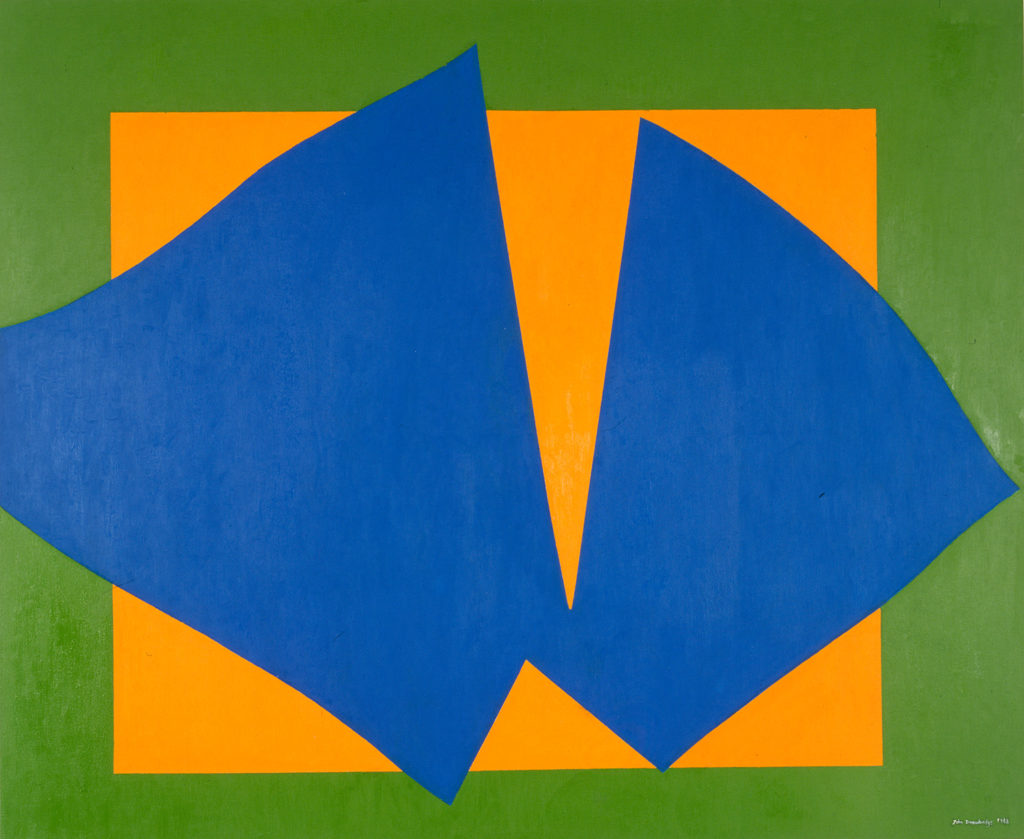CURATOR Gregory O'Brien PUBLICATION publisher City Gallery Wellington and Mallinson Rendel Publishers; essays, Gregory O'Brien, Lara Strongman, Gerald Barnett, Robert Macdonald
Wide Open Interior is the first retrospective of Wellington artist, John Drawbridge. Aged 71, Drawbridge has lived and worked in his Island Bay home for over forty years. The show's title refers to his recurring motif—a window or doorway opening on to the sea. This motif is based on his studio doorway, which opens onto a view of Cook Strait. The show includes twenty major oil paintings and over fifty works on paper.
Born in Karori in 1930, Drawbridge studies at Wellington Teachers Training College. He has his first show at Wellington’s Helen Hitchings Gallery in 1949. His early work includes landscape studies and storyboard sketches made on a six-week tour of the Southern Alps in 1949–50, preparing for a to-be-abandoned National Film Unit project, Ascent of Mt Aspiring. He goes on the formative trip with composer Douglas Lilburn, poet James K. Baxter, and photographer Brian Brake. Drawbridge also meets poet Charles Brasch who becomes a patron, publishing him in Landfall.
In 1957, he and Bill Culbert are awarded National Art Gallery travelling scholarships to study at the Central School of Arts and Crafts, London. (The show includes Rain at Sunset, which was inspired by his parting view of New Zealand from the liner Rangitane.)
In London, he socialises with other ex-pat artists, Robert MacDonald and Don Pebbles. At the Central School, he meets his wife-to-be, sculptor Tanya Ashken, who is deaf. His black-and-white etching representing her, Seated Woman (1960), is an evocation of silence and introspection. (Ashken will be the subject of his mezzotint print series, Tanya Going and Coming, 1968–78.)
While in Europe, Drawbridge is inspired by Matisse, Picasso, and Bonnard, who were printmakers as well as painters. His works will also cite Malevich, Morandi, and even pop art, in his irreverent 'girlie' prints, A Rather Transparent Girl 1 and 2 (1967).
In London, Drawbridge's etchings are exhibited at the Royal Academy and his paintings are shown alongside David Hockney’s in a group show. In 1963, he has a solo show at London's Redfern Gallery. In the Listener, curator O'Brien calls that show 'a lost moment in New Zealand art history’. (Half of the works from it, including Pacific Lagoon, are in our show.)
1963 is also the year Drawbridge's New Zealand House Mural is unveiled by the Queen in London. This highly abstracted and textured view of the New Zealand landscape remains in the House’s ground-floor reception hall for nearly three decades. In 1991, when the building's interior is reconfigured, the ten panels are shipped to New Zealand. They are exhibited at Wellington’s Shed 11, before being permanently installed in the National Archives building. (The Mural is the centrepiece of our show.)
After finishing the Mural, Drawbridge returns to live in Wellington. In 1964, he starts to teach at Wellington Polytechnic School of Design, continuing until 1986 and only resigning in 1990. Drawbridge tells New Zealand House and Garden, ‘New Zealand is an amazing country. I don't want to continue doing just abstract work which can be thought of as anonymously international. I think it is important to be able to respond to how you feel about things—the country, the land, the sea.'
In New Zealand, Drawbridge becomes known for large-scale public works. These include his murals for Evans Bay Intermediate School, Osaka's Expo '70 (reinstalled in the National Library), and Wellington's Beehive, and his stained-glass windows and stations of the cross for the Home of Compassion Chapel, Island Bay. (Our show's public programme includes tours to some of these works.)
Wellington is central to Drawbridge's life and work. The Gallery's association with him dates back to his inclusion in its inaugural group show, Opening, in 1980. For the current show, the Gallery runs an ad in the Evening Post playing on his status as 'one of Wellington's greatest exports’: ‘Not only has his work sold for more than David Hockney. Not only has he won the same international award as Picasso. Not only is his work in the collections of the V&A, the British Museum and the Museum of Modern Art, NY. He's also incredibly well bred. (John Drawbridge, born Wellington, 1930.)’
In the Dominion Post, peer and friend, painter Don Pebbles agrees that Drawbridge is neglected. 'I think it is one of New Zealand's great art scandals, because I've looked through art books and seen John's paintings not there, or not there in a way that would suggest the writer had any confidence in putting him there but felt he probably had to have somebody from Wellington.'

























































































